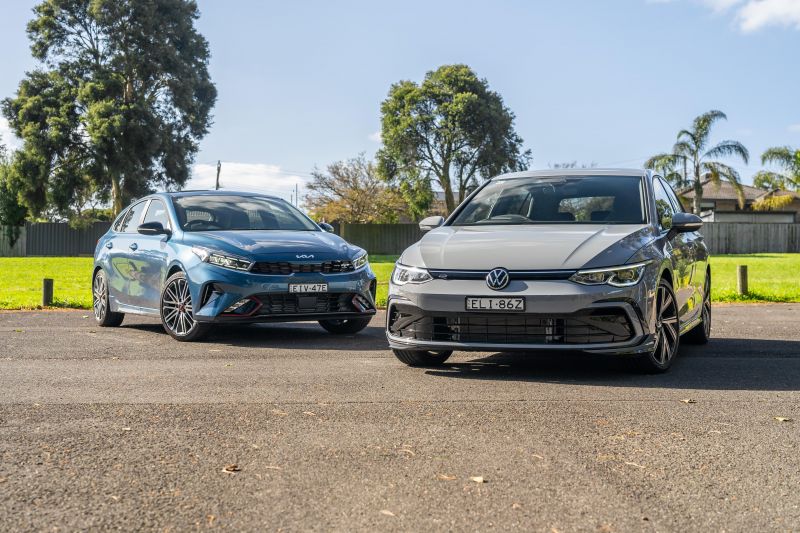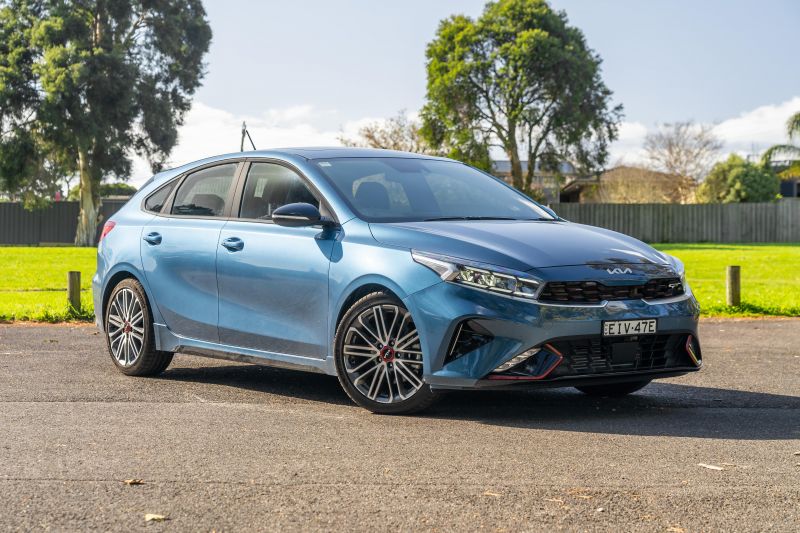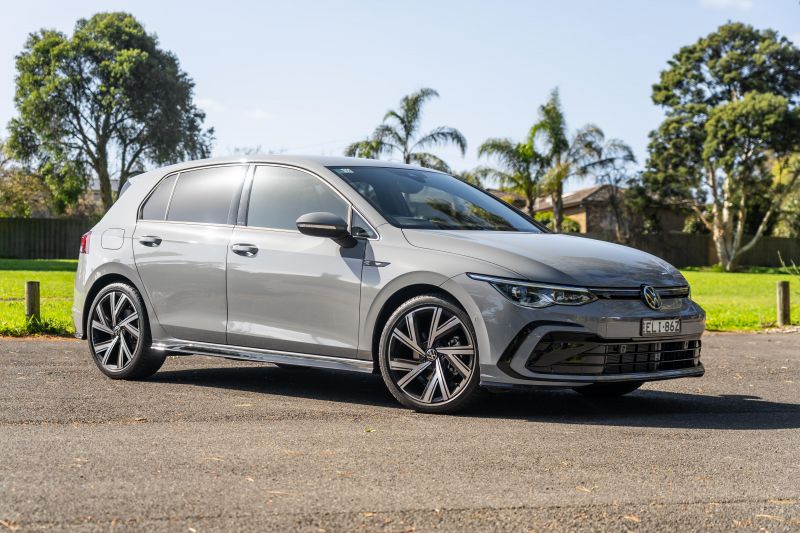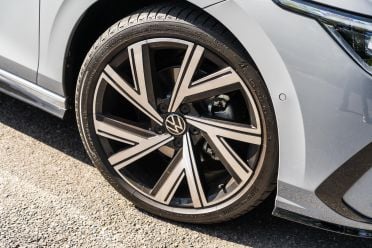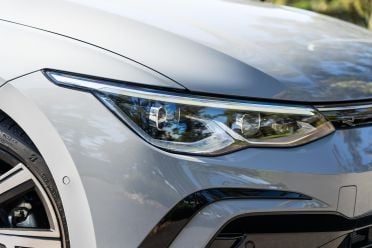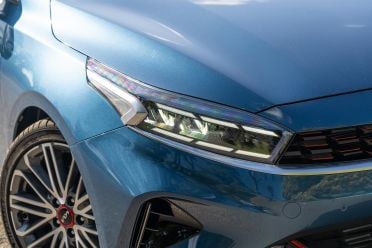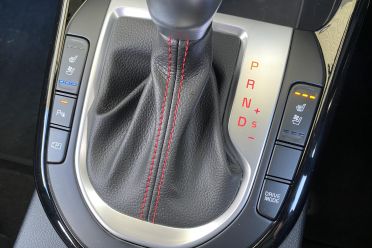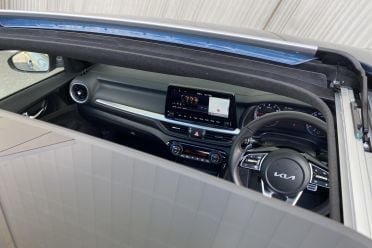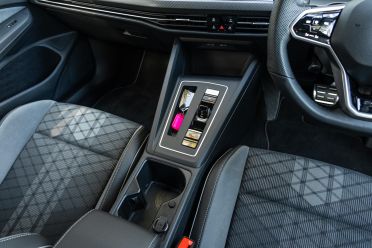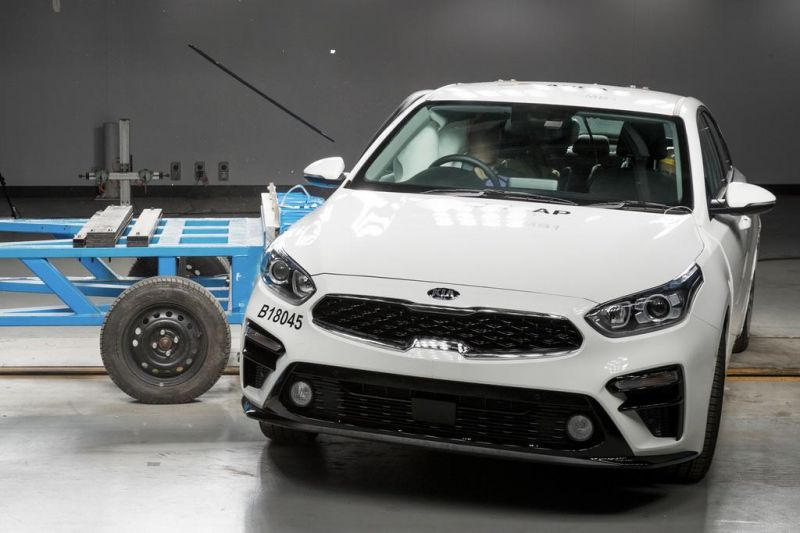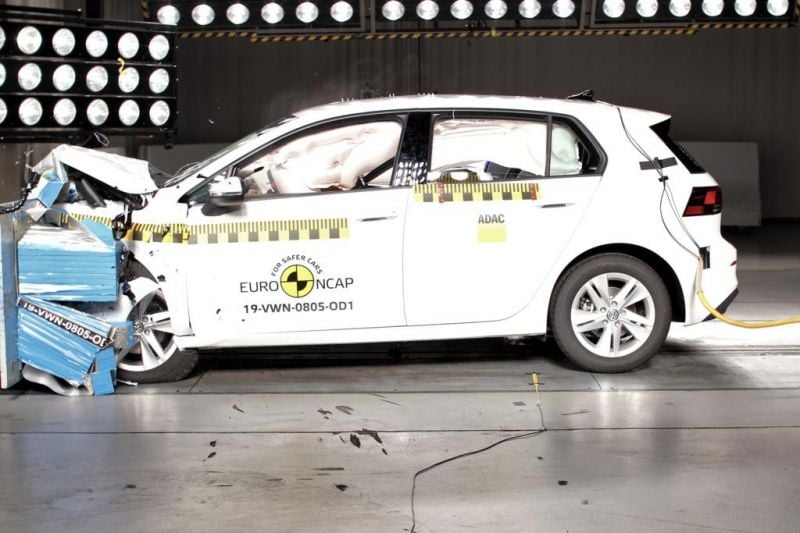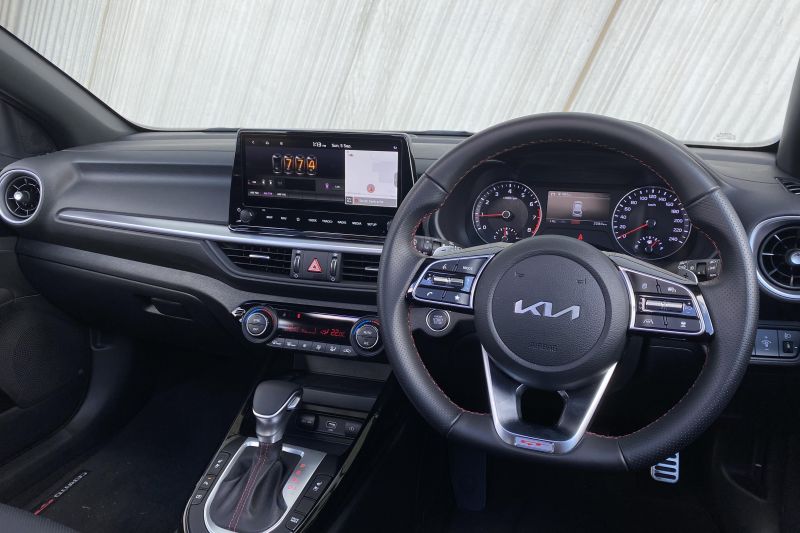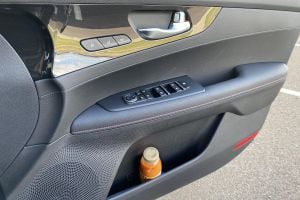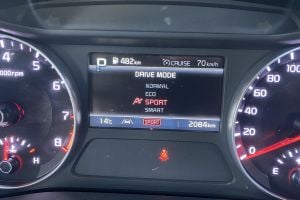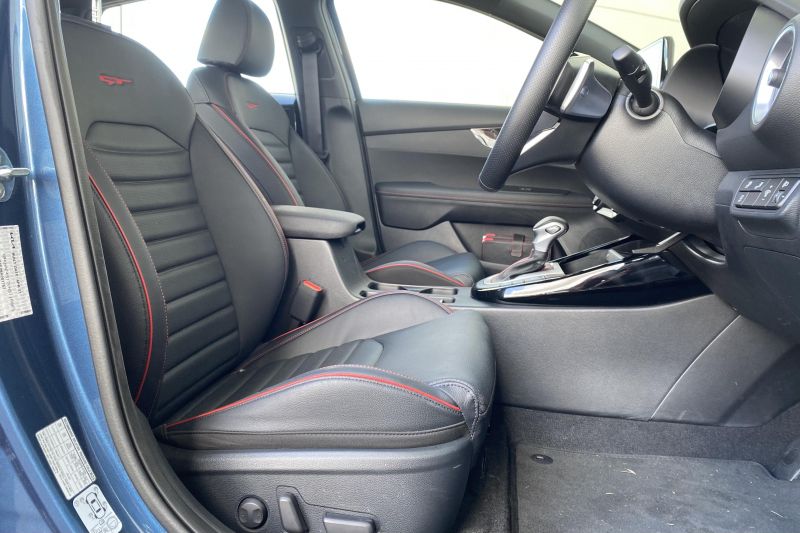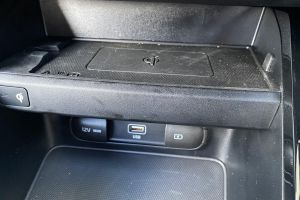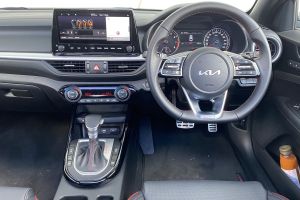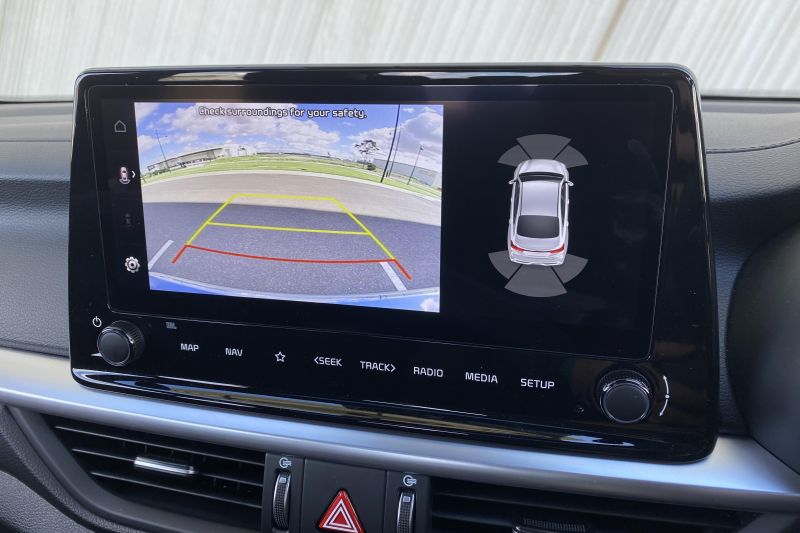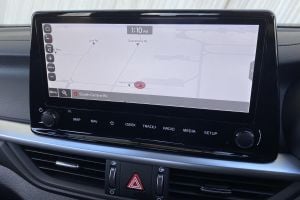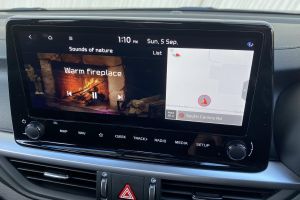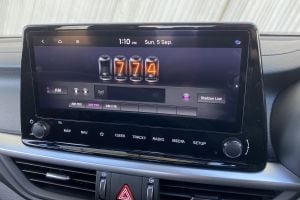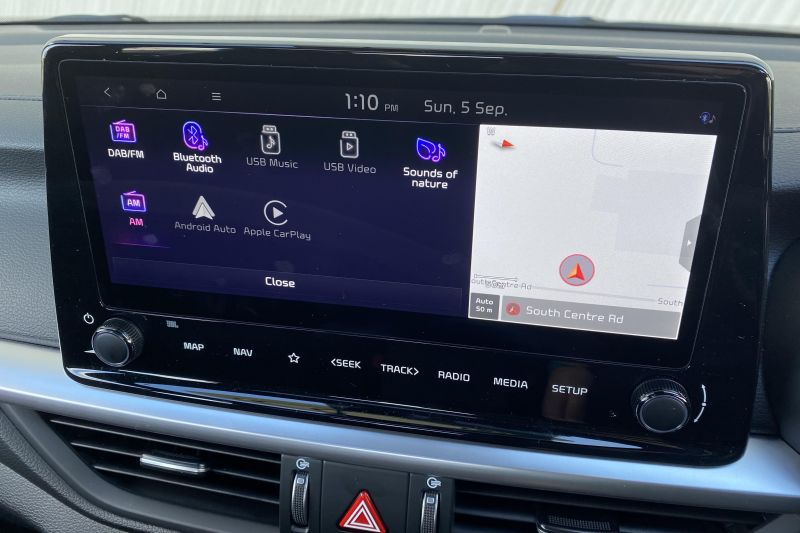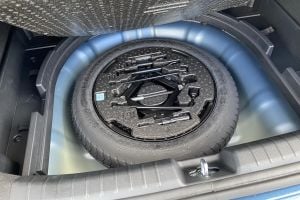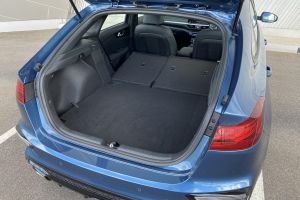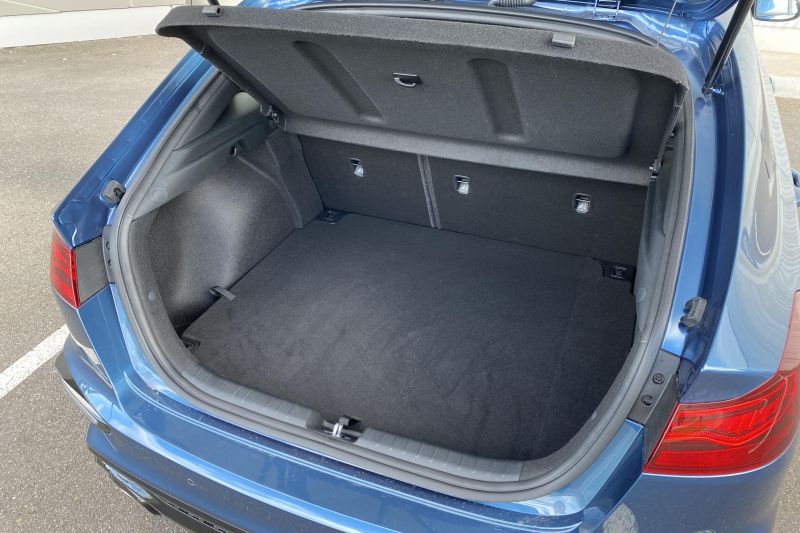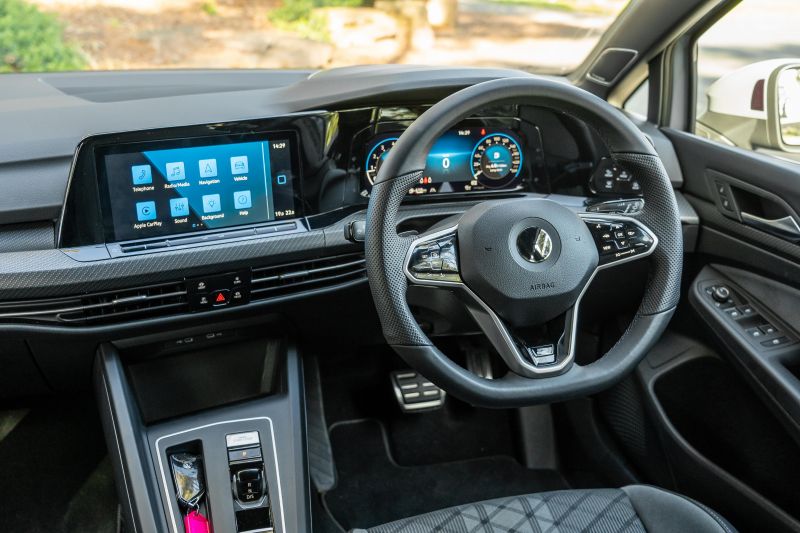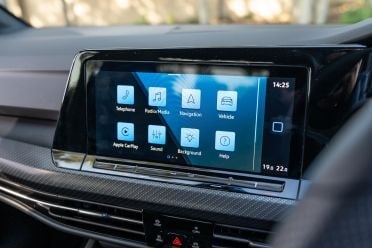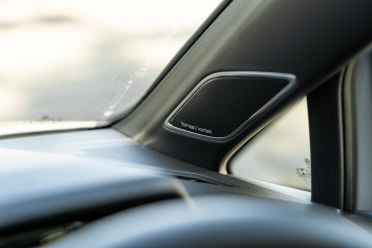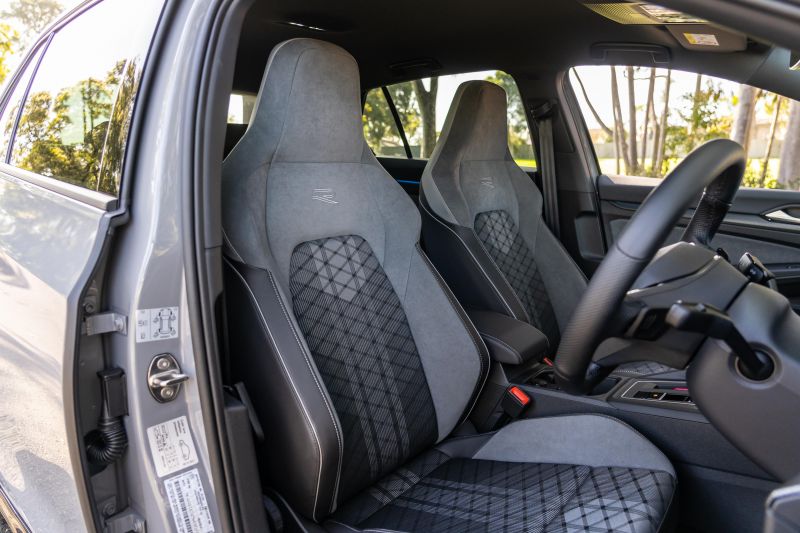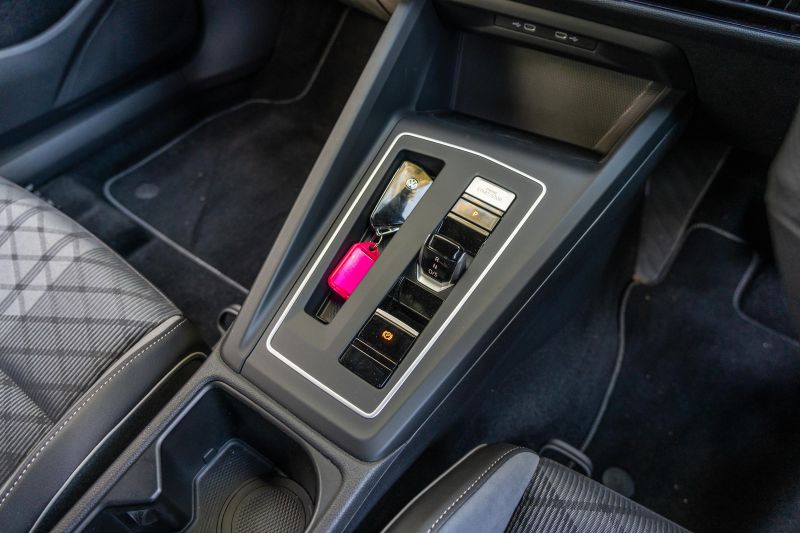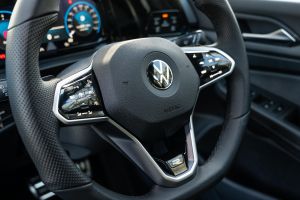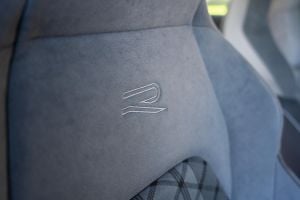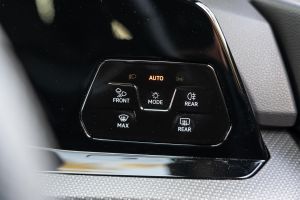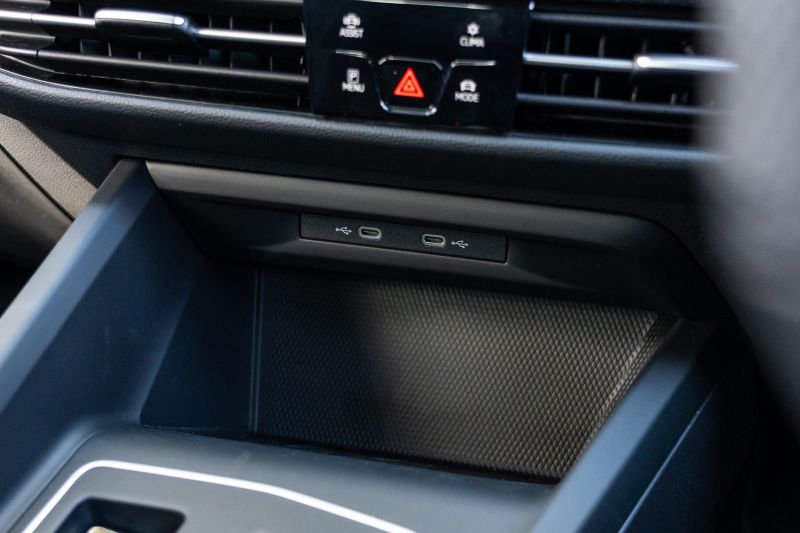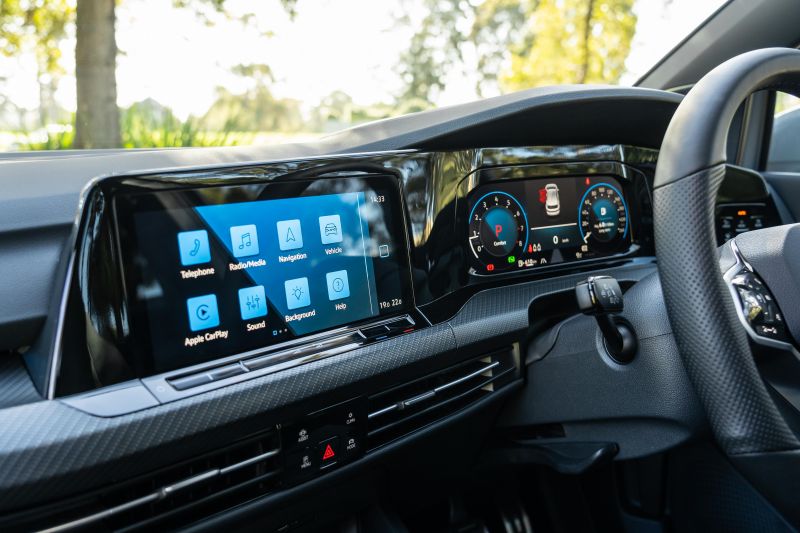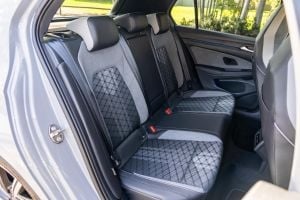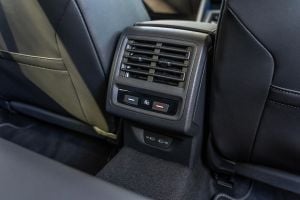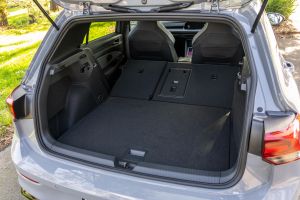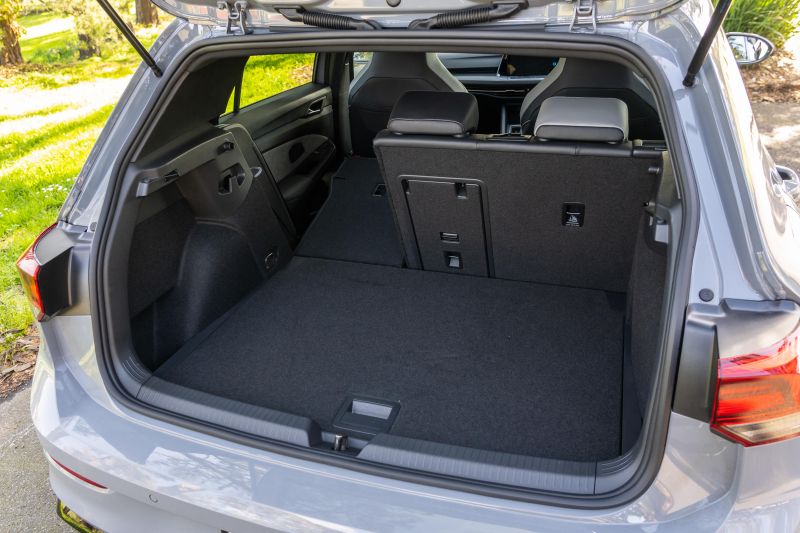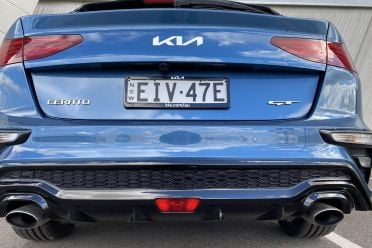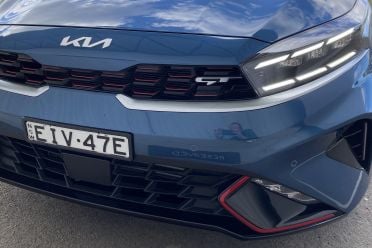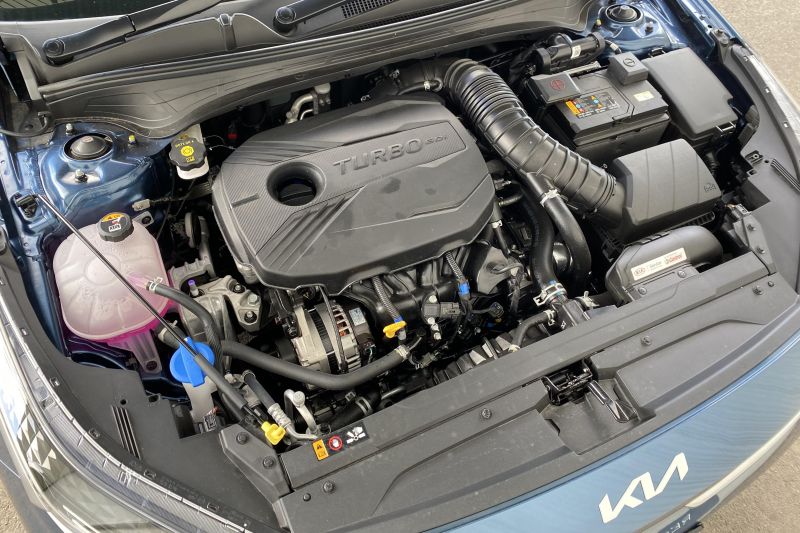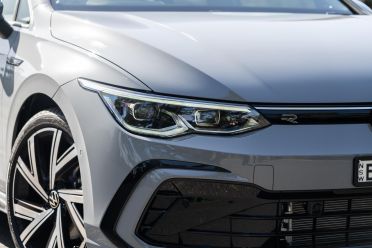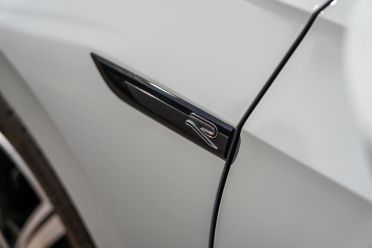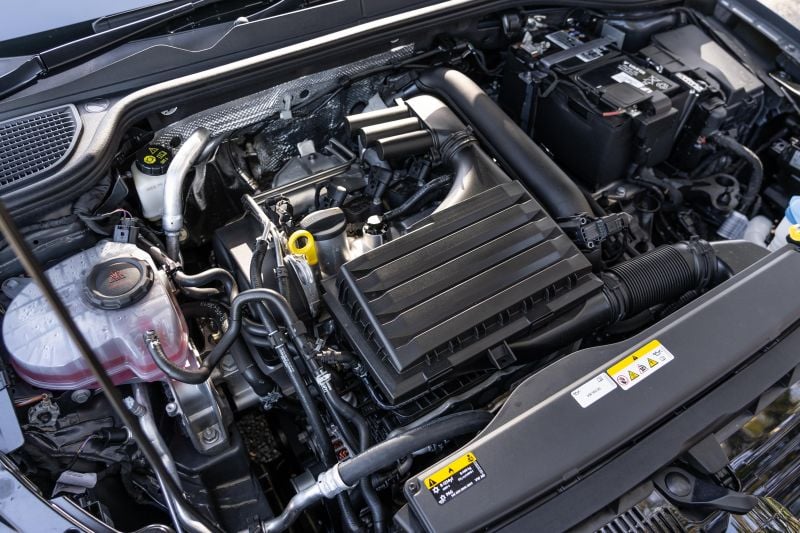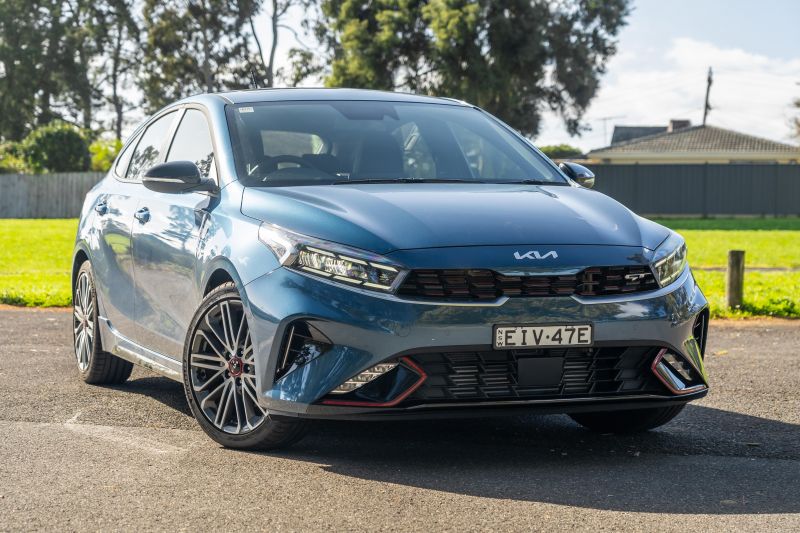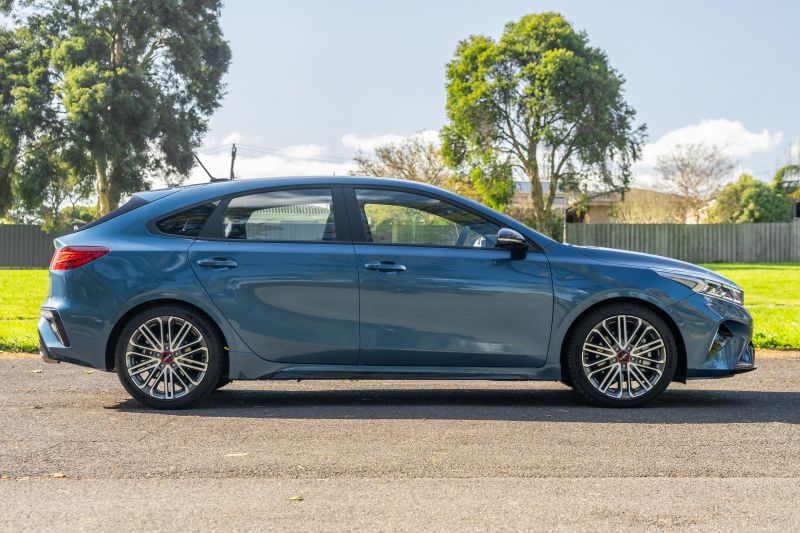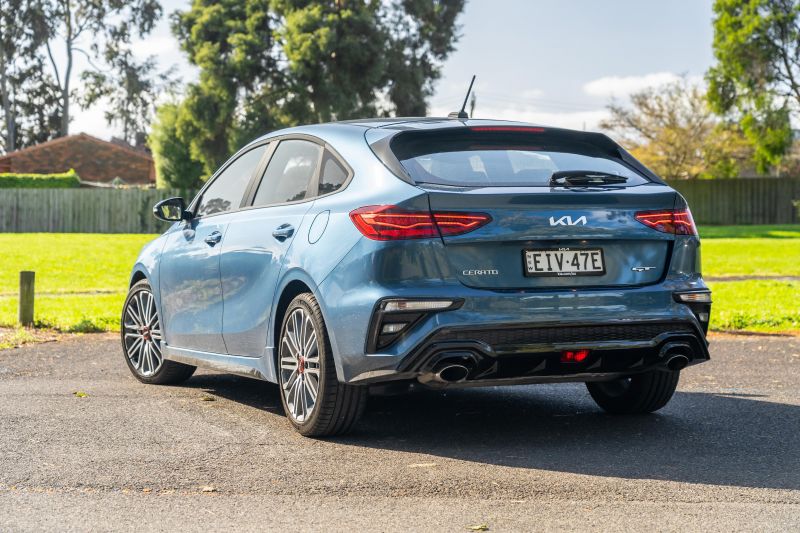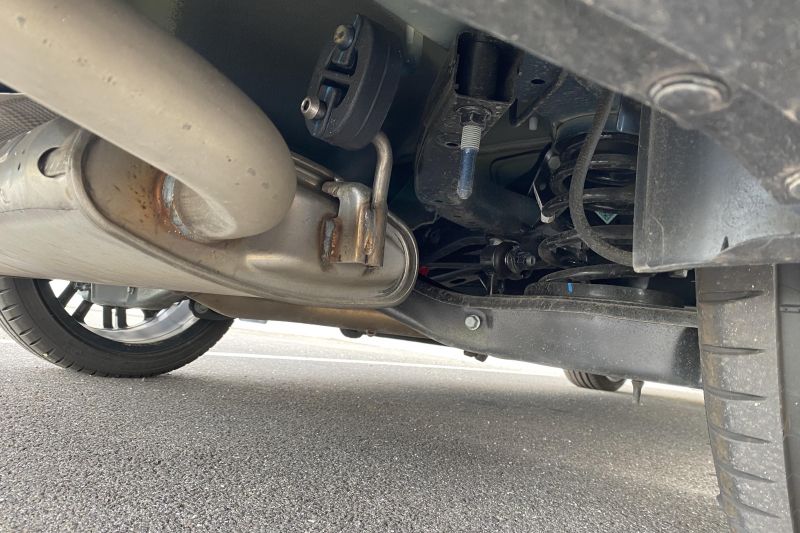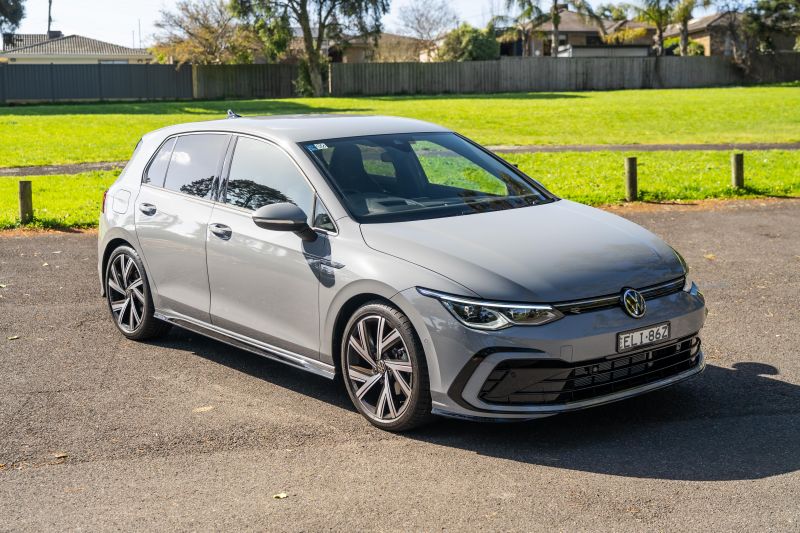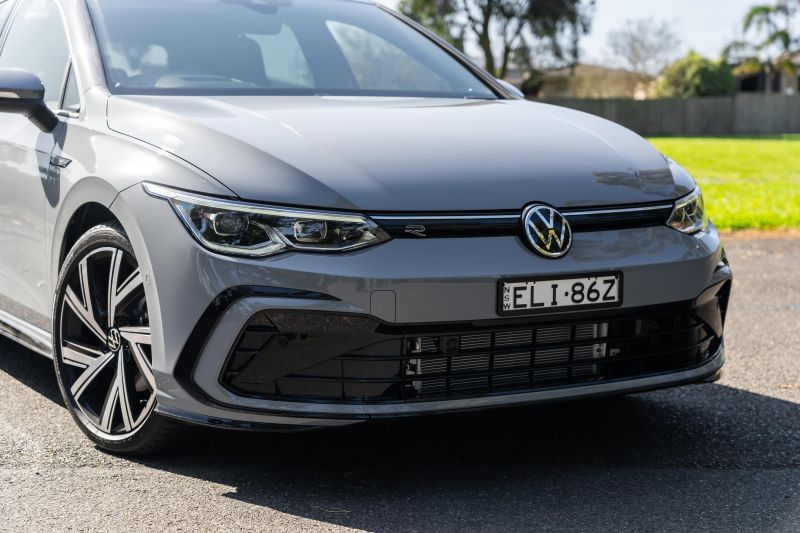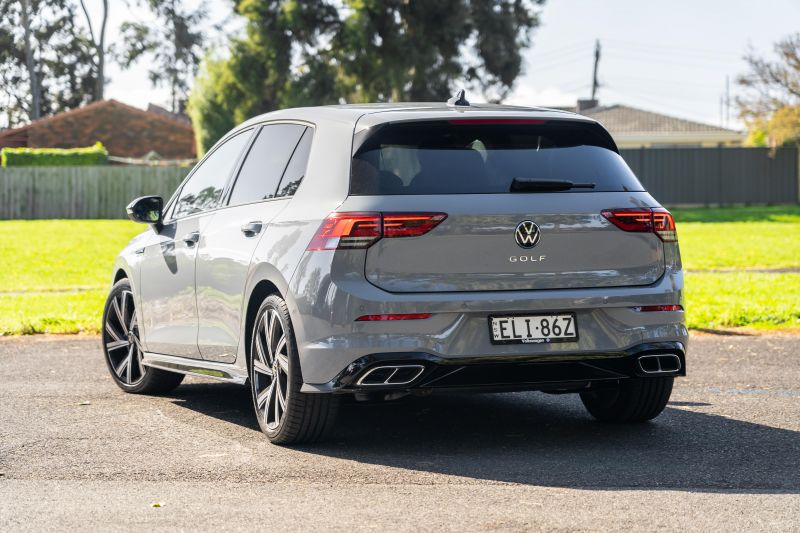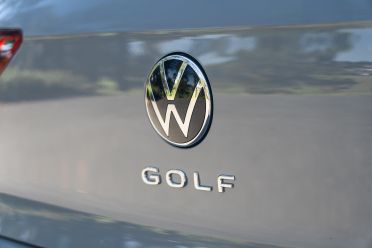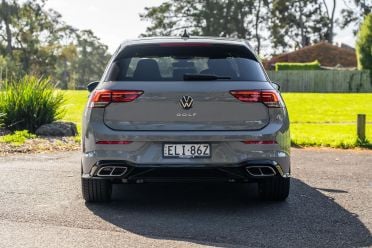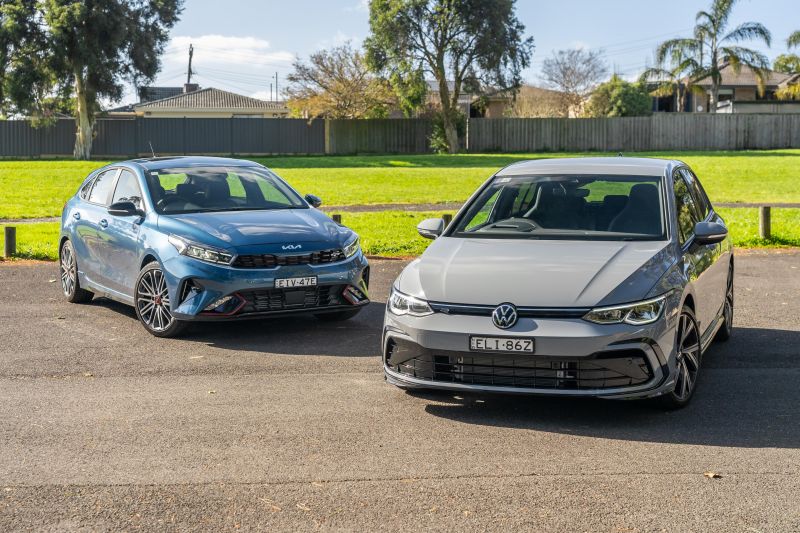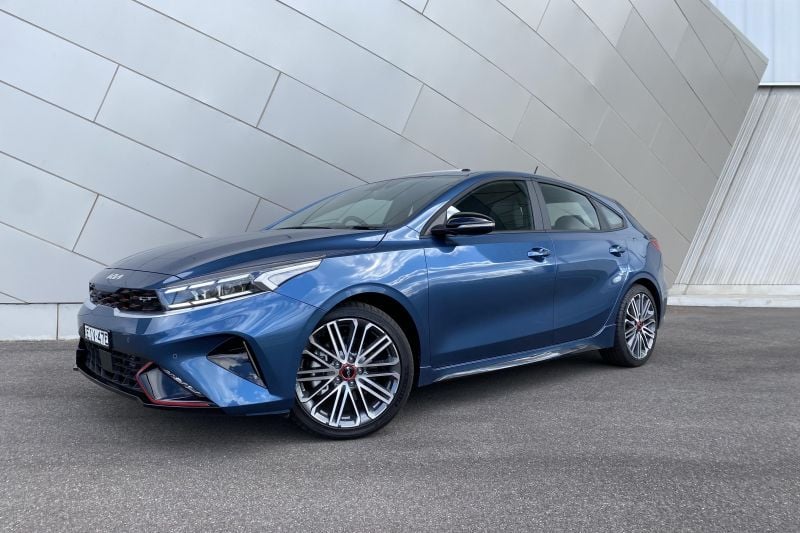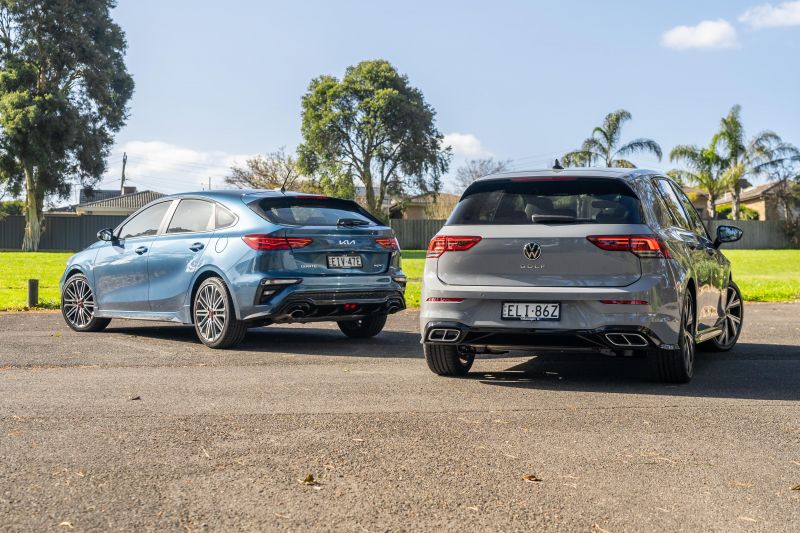Who makes the most convincing sporty-ish hatchback, Korea or Germany?
In the Korean corner we have the Kia Cerato GT. Fresh off a facelift, it comes with a long list of features, a powerful 1.6-litre engine, and a sharp-shifting dual-clutch transmission.
It’s also the value pick, backing its warm-hatch performance with a more tantalising drive-away price attached.
In the German corner is the brand new Volkswagen Golf ‘8’ R-Line. Although it looks like a heavily facelifted car, it’s taken a big step forward from its seventh-generation predecessor. Just look at that luxurious and tech-focused interior.
It’s down on power and torque compared to the Kia, and has swapped its dual-clutch for a torque converter automatic – none of which sounds sporty. But it does have a lower ride than the standard Golf, and more aggressive exterior.
Which recipe makes for a tastier hatchback?
How much?
Like the rest of the Cerato range, the GT is offered with a nationwide drive-away price of $36,990, based on a list price (before on-road costs) of $35,290.
The only option is paint; each of the premium finishes adds $520 to the price. With that in mind our Mineral Blue metallic test car cost $37,510 drive-away.
Things aren’t quite as simple at Volkswagen.
The Golf R-Line has a list price of $37,650 before on-road costs, but you can add a Sound and Vision Package ($1500 for a head-up display and 480W sound system) and a panoramic sunroof ($1800), the latter of which is standard in the Kia.
Metallic or pearlescent paint is a $300 option, premium metallic paint is $900.
With that in mind, our Moonstone Grey tester with the Sound and Vision package had a price of $39,250 before on-road costs. Without national drive-away campaign pricing, this suggests a drive-away figure of around $45,000.
Kia Cerato GT:
- $35,290 base list price
- $35,810 tested list price
- $37,510 campaign drive-away price
Volkswagen Golf R-Line:
- $37,650 base list price
- $39,450 tested list price
- $45,000 drive-away price (approx.)
What do you get?
Standard equipment in both
- Apple CarPlay and Android Auto
- Factory satellite navigation
- Reversing camera
- Front and rear parking sensors
- Adaptive cruise control
- Power-folding exterior mirrors
- Keyless entry and start
- Dual-zone climate control
- LED headlights and tail lights
- Wireless phone charging
- Paddle shifters
Unique equipment on the Kia
- Heated and ventilated front seats
- Leather seat trim
- DAB digital radio
- Powered sunroof
The Volkswagen counters with
- 10.25-inch digital instrument binnacle
- Wireless Apple CarPlay and Android Auto
- Suede and tartan-style cloth sports seats
Are they safe?
Both these cars have five-star safety ratings from ANCAP.
The Cerato was tested in 2019, and earned a five-star rating for high-spec models fitted with a full suite of active safety features.
It received an adult occupant protection score of 90 per cent, child occupant protection score of 83 per cent, vulnerable road user protection score of 72 per cent, and a safety assist score of 73 per cent.
The Golf was tested in 2019 and earned five stars across the range.
It scored 95 per cent for adult occupant protection, 89 per cent for child occupant protection, 76 per cent for vulnerable road user protection, and 80 per cent for safety assist.
Both these cars feature the following safety equipment:
- Lane-keeping assist
- Lane-following assist
- Autonomous emergency braking with pedestrian/cyclist detection
- Blind-spot monitoring
- Rear cross-traffic alert
- Adaptive cruise control
The Golf also features front cross-traffic assist, along with multi-collision brake (applies the brakes if you’re rear-ended), emergency assist (which calls 000 after an accident), and exit warning (which stops you opening the door into traffic or cyclists).
What are they like inside?
Kia Cerato GT
The Cerato feels more conventional than the Golf inside, with plenty of buttons and dials to poke and prod.
It’s absolutely loaded with equipment. Heated and ventilated front seats with power adjustment and the sunroof both stand out after the Golf, while the flat-bottom steering wheel is every bit as nice to hold as the R-Line unit in the VW.
The driving position in the Cerato doesn’t feel particularly sporty, unfortunately. You’re perched too high (my head almost touches the roof lining), evidence of its economy car roots, and the seats lack the range of adjustment you get in the Golf.
There’s almost no learning curve here. The climate control binnacle is simple to use, the touchscreen infotainment likewise, and the gear selector is an old-fashioned PRND slider.
I can understand why some buyers would see that as a drawback. The Cerato lacks the show-car sizzle of the Golf, it’s less exciting. But it’s easy to use, and doesn’t have layers of software standing between you and what should be a simple task.
Material quality is a mixed bag. The main touch points are trimmed in what feels like high-end leather, and the dash is topped with soft plastic, but you don’t have to go far to find harder stuff down low.
Where the Volkswagen’s fonts and colours are consistent, the red climate controls in the Cerato don’t quite match the flashy infotainment system, which in turn has a slightly different feel to the trip computer.
Then again, the Kia is much cheaper than the Golf.
The 10.25-inch touchscreen in the Cerato is rolling out across the Hyundai and Kia range at the moment. With wired smartphone mirroring and factory navigation it has everything you need, though the trio of function buttons in the top-left corner of the screen are a bit of a reach.
Thankfully Kia has fitted a proper volume knob and shortcut buttons on the centre console, and there’s a button to access Siri or Google Assistant on the steering wheel when you’re using smartphone mirroring.
Down back the Cerato matches the Golf with air vents, a fold-down central armrest, and a USB charging port – although the port in the Kia is USB-A, not USB-C.
Rear space is decent, with more legroom than the Golf but slightly less headroom thanks to its sloping roofline. The outboard seats have ISOFIX points, and there are three top-tether points for child seats. The rear seats fold 60/40, but there’s no central ski port.
Boot space is 428L with the rear seats in place, and Kia doesn’t quote a seats-down figure. There’s a space-saver spare tyre under the floor. You can also opt for a sedan at identical pricing.
Volkswagen Golf R-Line
Volkswagen didn’t mess too much with its own formula as it moved through the fifth, sixth, and seventh-generation Golf, but it’s ripped up the history books to create the Mk 8.
Stepping into the Golf is like stepping forward a decade. Buttons are few and far between, and two big screens are standard across the range. It looks slick, and a lot of the stuff that was good about the last Golf carries over.
The driving position is a strong point. The driver’s seat drops down low and slides back far enough to accomodate long-legged occupants, the steering wheel feels great in the hands, and vision out the heavily-reclined windscreen is good.
At circa $45,000 drive-away though, it’s a bit disappointing the sports seats aren’t heated, ventilated, or power-adjustable.
I’d read reports of hard, scratchy plastics and noticeable cost-cutting in the new Golf, but the R-Line is up to the standard you’d expect of a high-end mainstream hatch.
The front doors are topped with soft-touch trim, the dash has a matte finish instead of the shiny look of the Kia, and the tiny gear selector clicks positively into place.
There are some hard plastics hidden down low, and the rear doors haven’t been treated to the same soft-touch tops as the fronts, but there’s no doubt the Golf is finished to a higher standard than the Cerato.
Some Golf staples are noticeably absent though. The door bins are still felt-lined to stop things rattling around, but there’s no fold-down storage tray to the right-hand side of the steering wheel.
The cupholders aren’t hidden under a sliding cover anymore, and the 12V plug is now covered with a cheap-feeling plastic lid.
They’re small things, but it’s the small things that have always made the Golf feel that little bit more special than its hatchback rivals. Volkswagen has fallen short of its own high standards in a few places.
As for the technology? It’s a mixed bag.
The driver’s display is excellent, with crisp graphics and just the right amount of information, but in eliminating buttons Volkswagen has also steepened the learning curve involved in even the simplest tasks.
You need to press a gloss black touch button on the dash and fiddle with the touchscreen just to change the fan speed, for example, which means you lose your navigation or media display.
It means more time with your eyes off the road, and more fingerprints on the screen and its gloss black surround, even if what you want to do should be simple. Sure, familiarity helps, but there’s no getting around the fact things that used to be easy are now harder.
At least the graphics are clean, the responses sharp, and the customisation options nearly endless. The bones of a good system are there, but they’re hidden beneath a frustrating layer of user unfriendliness.
Rear seat passengers are treated to decent legroom and headroom, with space for average-sized adults behind average-sized adults. Not only are there vents and USB-C chargers, the climate control pod allows rear passengers to set their own temperature.
There’s also a fold-down armrest back there. Visibility is decent for short passengers, despite a high-ish windowline. The outboard seats have ISOFIX points, and there are three top-tether points for child seats. The rear seats fold 60/40 (although there’s a central ski port).
Boot space is 374L with the rear seats in place, and 1230L with them folded. The space itself is broad and practical, and there’s no major loading lip when you pop the boot using the Volkswagen badge. There’s a space-saver spare tyre under the floor.
| Kia Cerato | VW Golf | |
|---|---|---|
| Length | 4510mm | 4286mm |
| Width | 1800mm | 1789mm |
| Height min | 1440mm | 1456mm |
| Wheelbase | 2700mm | 2636mm |
| Boot | 428L | 374L |
What’s under the bonnet?
Kia Cerato GT
The Cerato GT is powered by an unchanged version of the 1.6-litre turbocharged four-cylinder petrol engine from its predecessor.
Peak power is 150kW and peak torque is 265Nm, sent to the front wheels through a seven-speed dual-clutch transmission.
Claimed fuel economy is 6.8L/100km on the combined cycle, and the fuel tank holds 50L. Unlike the Golf, the Cerato drinks regular 91 RON unleaded fuel.
Volkswagen Golf R-Line
Power in the Golf R-Line comes from the same 1.4-litre turbocharged four-cylinder petrol engine as the wider Golf range, making the same 110kW of power and 250Nm of torque.
It’s sent to the front wheels through an eight-speed torque converter automatic, rather than the seven-speed dual-clutch (DSG) we’ve come to know from Volkswagen.
Claimed fuel economy is 5.8L/100km on the combined cycle, and the fuel tank holds 50L. The Golf drinks more expensive 95RON premium unleaded.
| Kia Cerato | VW Golf | |
|---|---|---|
| Fuel type | Petrol | Petrol |
| Displacement | 1.6-litre | 1.4-litre |
| Induction | Turbocharged | Turbocharged |
| Power | 150kW @ 6000rpm | 110kW @ 4500rpm |
| Torque | 265Nm @ 1500-4500rpm | 250Nm @ 1500-4000rpm |
| Transmission | 7-speed DCT | 8-speed auto |
| Driven wheels | FWD | FWD |
| Fuel use | 6.8L/100km | 5.8L/100km |
How do they drive?
Kia Cerato GT
Kia isn’t known for building hardcore cars, but the Cerato GT feels purposeful from the moment you get behind the wheel. There’s more weight to the steering than in the Golf, and the ride is firmer.
Unlike the Golf, the Cerato has a dual-clutch transmission. Strange times. It isn’t torque-converter-smooth off the mark, and can be a bit slow moving from drive to reverse, but the 2022 model’s setup feels smarter than the pre-update car.
Where the earlier model sometimes tripped over itself on the shift from first to second gear, the 2022 car tested here felt more confident.
Kia still can’t match old DSG-equipped Volkswagen models for snappiness when it comes to full-speed shifts, but the transmission in the Cerato is sharper than the conventional automatic in the Golf.
The four-cylinder engine in the Cerato has a very different character to the smooth-moving motor in the Golf. There’s a hint of lag off the mark, but it pulls harder through the mid-range and revs more freely than the R-Line, backed by a more aggressive exhaust note.
The 100km/h sprint takes around 7.0 seconds (independent tests have it between 6.9 and 7.3 seconds), making it 1.5 seconds faster than the Golf. This is a properly warm hatchback based on the way its accelerates, where the R-Line is a regular hatch in activewear.
It handles like a warm hatch, too. I remember being blown away by how nimble the pre-facelift GT was, and the update has done nothing to diminish its capabilities.
Where the Golf feels stable and planted, the Kia manages to feel lively and engaging without ever getting nervous.
The trade-off is the ride quality. The Kia is noticeably firmer than the VW around town, picking up small imperfections and transmitting them to the cabin. It never quite settles down, and bigger hits bring about a noticeable thud.
It’s clear Kia has chased a purposeful, sporty feeling in the GT, but other Hyundai Group products strike a better balance between ride and handling. Make sure you test drive the car on your local roads to make sure the suspension isn’t going to wear you out.
Like the Golf, the Cerato gets a bit noisy at highway speeds. Its adaptive cruise is more prone to drifting over the speed limit though, and Kia’s active lane-centring is way more aggressive than it needs to be.
Thankfully, you only need to turn it off once.
Volkswagen Golf R-Line
For all that’s changed, the Mk 8 Golf still feels like a Golf. It’s smooth and quiet, with a planted feeling that wouldn’t be out of place in a bigger, more expensive car.
The switch from a dual-clutch transmission to a more conventional torque converter means the new Golf uses more fuel than its predecessor, but it also makes it smoother and easier to drive in the city.
Even the best dual-clutch transmissions carry some kind of learning curve, but the eight-speeder in the new Golf doesn’t. It’s smart enough to keep the 1.4-litre engine in its torque band most of the time, slurring inoffensively from gear-to-gear when you’re cruising.
As has always been the case, the turbocharged four-cylinder engine in the Golf is an effortless companion. Its outputs are down on what you get in the latest warm hatches from Hyundai and Kia, but its buttery smooth power delivery and torquey mid-range mean you never need to work it hard.
Where it does feel like a backwards step is when you’re in a hurry. Even in Sport mode the eight-speed Golf doesn’t snap through the ratios with the crisp confidence of a DSG, and taking charge with the paddles isn’t nearly as satisfying.
Is that likely to worry the average owner? Probably not, although it’s arguably more of an issue in the sporty Golf R-Line than in its more demure siblings.
The coat of polish applied to the engine extends to the ride and handling, too. The R-Line sits 15mm lower than the regular Golf, but it soaks up the worst the city can throw at it without breaking a sweat.
It’s a bit firmer than the related Skoda Octavia, but it’s still perfectly usable day-to-day. In traditional Volkswagen fashion, body control is tight without feeling outright sporty. It deals with speed bumps in one movement, the body settling quickly.
Unlike some of its rivals, Volkswagen has stuck with a multi-link rear suspension on the Golf (the Kia also has this setup). That has a negative impact on boot space, but it also contributes to the car’s planted, neutral feeling from behind the wheel.
Flick it into a corner and the nose just goes where you want it to, with very little in the way of understeer unless you’re carrying too much pace.
Even in R-Line guise the Golf majors on low-fuss stability rather than outright thrills, although it’ll put a smile on your face if you’re willing to take it by the scruff of the neck.
It’s not perfect, though. The tyres are noisy on the highway, especially Australian coarse chip highways, and Volkswagen’s adaptive cruise control won’t pass to the left of a slower car.
In Europe, where lane discipline is drummed into drivers from day one, that’s a good thing. In Australia, where it’s common for drivers to sit in the right lane doing 10km/h below the limit, it’s annoying.
| Kia Cerato | VW Golf | |
|---|---|---|
| Weight | 1395kg | 1304kg |
| Front suspension | MacPherson strut | MacPherson strut |
| Rear suspension | Multi-link | Multi-link |
| Dampers | Passive | Passive |
| Steering type | Electro-mechanical | Electro-mechanical |
| Front brakes | Ventilated disc | Ventilated disc |
| Rear brakes | Solid disc | Solid disc |
| Turning circle | 10.6 metres | 10.9 metres |
Cost of ownership
Kia Cerato GT
The Kia Cerato GT is backed by a seven-year and unlimited-kilometre warranty.
Maintenance is required every 12 months or 10,000km. Drivers who are covering long distances should note the short 10,000km intervals.
The first five years or 50,000km of maintenance in the Cerato will set you back $1890 using Kia’s capped-price program.
Volkswagen Golf R-Line
The Golf R-Line is backed by a five-year and unlimited-kilometre warranty.
Maintenance is required every 12 months or 15,000km
Volkswagen offers a five-year prepaid service package for $2100 for five years or 75,000km, which is a huge saving of $797 over paying-as-you-go.
CarExpert’s Pick
You might be wondering why we’ve put the Golf and Cerato head-to-head, given there’s a pretty big price difference by the time you’ve sorted out your on-road costs (less so at list pricing).
The reason is pretty simple: they take distinctly different approaches, but they’re both trying to plug the gap between your grandma’s commuter hatchback and something like a Golf GTI or Hyundai i30 N.
The Golf R-Line builds on the strengths of its predecessor, with a sharp exterior and polished drive. Even without the same power as the Kia, the Volkswagen has more than enough punch to put a smile on your face.
It’s a shame the technology lacks the same polish as the oily bits, although software updates mean Volkswagen could improve it over time.
Kia has taken a totally different approach. The Cerato GT doesn’t have the same high-end feel as the Golf, but it’s far more involving from behind the wheel. The engine pulls harder, the ride is firmer, and the steering is more purposeful.
It isn’t quite as polished, but the bigger fun factor and smaller price tag give the Cerato the win in this comparison.


